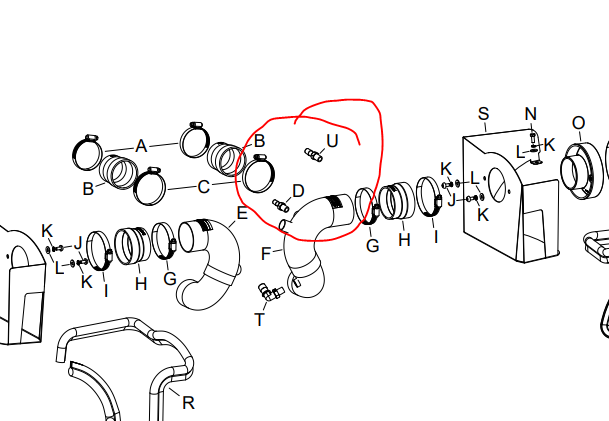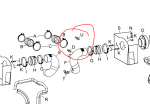- Messages
- 90
- Reactions
- 39
- State
- CA
- Country
- United States
- What I Drive
- Kia Stinger GT
So, as some of you already know, I recently installed a K&N intake and my ISG stopped working. This lead me to look into several things, but long story short, I figured out that the pressure of a particular line affects whether ISG engages or not when the brake pedal is depressed.
First things first, when you look at the K&N installation instructions, you'll notice there are two different sized fittings for the driver side intake tube's upper hole (I've circled it in the image below, referencing parts U and D). Here's where it's interesting: the 3/8" fitting barb was too small when I placed it in the hose. It didn't seal whatsoever as it could freely slide in and out. Assuming that statement didn't awaken your inner 15 year old and you're still reading, I had to use the 1/2" fitting in order for there to be a secure fit with my hoes-err I mean hose.

Where does this hose lead, you ask? It's easy for you to investigate if you take off the engine cover, but it goes to a valve that splits off into three directions: one goes into the crankshaft area where the position sensor is; another goes directly into the intake (presumably to vent pressure); and the third goes into the master brake cylinder. The pressure from this line changes when you press the brake pedal, and is inversely affected when the line to the intake's pressure is different. By using the 1/2" fitting, I decreased pressure in the line too much, effectively disabling ISG. By moving to the 3/8" fitting (and consequently buying 3/8" hose since, again, the 3/8" was entirely loose inside the hose end), I've effectively increased the pressure reading from this line to high enough levels to engage ISG again. I tested this initially by using a hose clamp on the 1/2" fitting. By tightening it down and restricting the hose, ISG worked again.
How can you disable ISG? Decrease pressure in this line from the intake. In my factory intake tube, the hole on the inside of the intake tubing is actually very tiny even though the fitting itself is much larger. By moving to a smaller fitting/hose, I have effectively mimicked this tiny hole in the factory intake as opposed to the full size hole drilled in my K&N intake tube.
Due to my testing, disabling ISG in this matter does come with a caveat: my MPGs seem to have dropped because decreasing pressure means increasing airflow through this line which is unmetered air into the intake. This small amount causes the engine to run rich in an effort to compensate, so keep that in mind. It seemed to have zero impact on power, however.
K&N doesn't tell you much about the effect of using the "wrong" fitting, as I suspect they also ran into what happened to me and explains why they include both fittings. In my case, using the "right" one was the wrong one. I suspect K&N would not want to be blamed for ISG problems, so they simply didn't mention that this would happen if the wrong fitting is used. However, now you all know what that fitting/hose affects.
Sooo, do this at your own risk. Decrease pressure on that line by opening up its flow until your ISG stops working, and voila.
First things first, when you look at the K&N installation instructions, you'll notice there are two different sized fittings for the driver side intake tube's upper hole (I've circled it in the image below, referencing parts U and D). Here's where it's interesting: the 3/8" fitting barb was too small when I placed it in the hose. It didn't seal whatsoever as it could freely slide in and out. Assuming that statement didn't awaken your inner 15 year old and you're still reading, I had to use the 1/2" fitting in order for there to be a secure fit with my hoes-err I mean hose.

Where does this hose lead, you ask? It's easy for you to investigate if you take off the engine cover, but it goes to a valve that splits off into three directions: one goes into the crankshaft area where the position sensor is; another goes directly into the intake (presumably to vent pressure); and the third goes into the master brake cylinder. The pressure from this line changes when you press the brake pedal, and is inversely affected when the line to the intake's pressure is different. By using the 1/2" fitting, I decreased pressure in the line too much, effectively disabling ISG. By moving to the 3/8" fitting (and consequently buying 3/8" hose since, again, the 3/8" was entirely loose inside the hose end), I've effectively increased the pressure reading from this line to high enough levels to engage ISG again. I tested this initially by using a hose clamp on the 1/2" fitting. By tightening it down and restricting the hose, ISG worked again.
How can you disable ISG? Decrease pressure in this line from the intake. In my factory intake tube, the hole on the inside of the intake tubing is actually very tiny even though the fitting itself is much larger. By moving to a smaller fitting/hose, I have effectively mimicked this tiny hole in the factory intake as opposed to the full size hole drilled in my K&N intake tube.
Due to my testing, disabling ISG in this matter does come with a caveat: my MPGs seem to have dropped because decreasing pressure means increasing airflow through this line which is unmetered air into the intake. This small amount causes the engine to run rich in an effort to compensate, so keep that in mind. It seemed to have zero impact on power, however.
K&N doesn't tell you much about the effect of using the "wrong" fitting, as I suspect they also ran into what happened to me and explains why they include both fittings. In my case, using the "right" one was the wrong one. I suspect K&N would not want to be blamed for ISG problems, so they simply didn't mention that this would happen if the wrong fitting is used. However, now you all know what that fitting/hose affects.
Sooo, do this at your own risk. Decrease pressure on that line by opening up its flow until your ISG stops working, and voila.
Attachments
-
79.8 KB Views: 57
-
1
- Show All

